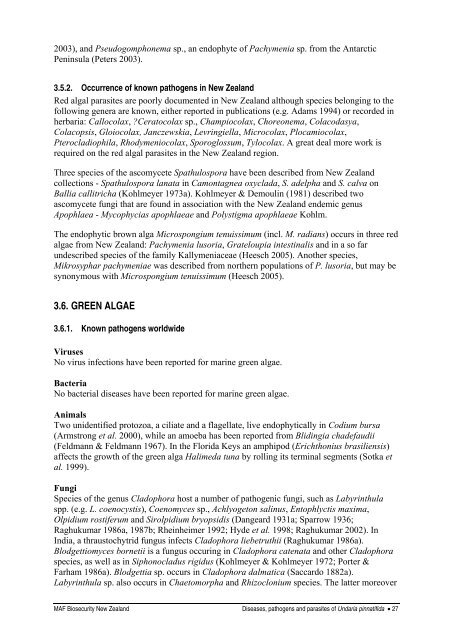Diseases, pathogens and parasites of Undaria pinnatifida
Diseases, pathogens and parasites of Undaria pinnatifida
Diseases, pathogens and parasites of Undaria pinnatifida
You also want an ePaper? Increase the reach of your titles
YUMPU automatically turns print PDFs into web optimized ePapers that Google loves.
2003), <strong>and</strong> Pseudogomphonema sp., an endophyte <strong>of</strong> Pachymenia sp. from the Antarctic<br />
Peninsula (Peters 2003).<br />
3.5.2. Occurrence <strong>of</strong> known <strong>pathogens</strong> in New Zeal<strong>and</strong><br />
Red algal <strong>parasites</strong> are poorly documented in New Zeal<strong>and</strong> although species belonging to the<br />
following genera are known, either reported in publications (e.g. Adams 1994) or recorded in<br />
herbaria: Callocolax, ?Ceratocolax sp., Champiocolax, Choreonema, Colacodasya,<br />
Colacopsis, Gloiocolax, Janczewskia, Levringiella, Microcolax, Plocamiocolax,<br />
Pterocladiophila, Rhodymeniocolax, Sporoglossum, Tylocolax. A great deal more work is<br />
required on the red algal <strong>parasites</strong> in the New Zeal<strong>and</strong> region.<br />
Three species <strong>of</strong> the ascomycete Spathulospora have been described from New Zeal<strong>and</strong><br />
collections - Spathulospora lanata in Camontagnea oxyclada, S. adelpha <strong>and</strong> S. calva on<br />
Ballia callitricha (Kohlmeyer 1973a). Kohlmeyer & Demoulin (1981) described two<br />
ascomycete fungi that are found in association with the New Zeal<strong>and</strong> endemic genus<br />
Apophlaea - Mycophycias apophlaeae <strong>and</strong> Polystigma apophlaeae Kohlm.<br />
The endophytic brown alga Microspongium tenuissimum (incl. M. radians) occurs in three red<br />
algae from New Zeal<strong>and</strong>: Pachymenia lusoria, Grateloupia intestinalis <strong>and</strong> in a so far<br />
undescribed species <strong>of</strong> the family Kallymeniaceae (Heesch 2005). Another species,<br />
Mikrosyphar pachymeniae was described from northern populations <strong>of</strong> P. lusoria, but may be<br />
synonymous with Microspongium tenuissimum (Heesch 2005).<br />
3.6. GREEN ALGAE<br />
3.6.1. Known <strong>pathogens</strong> worldwide<br />
Viruses<br />
No virus infections have been reported for marine green algae.<br />
Bacteria<br />
No bacterial diseases have been reported for marine green algae.<br />
Animals<br />
Two unidentified protozoa, a ciliate <strong>and</strong> a flagellate, live endophytically in Codium bursa<br />
(Armstrong et al. 2000), while an amoeba has been reported from Blidingia chadefaudii<br />
(Feldmann & Feldmann 1967). In the Florida Keys an amphipod (Erichthonius brasiliensis)<br />
affects the growth <strong>of</strong> the green alga Halimeda tuna by rolling its terminal segments (Sotka et<br />
al. 1999).<br />
Fungi<br />
Species <strong>of</strong> the genus Cladophora host a number <strong>of</strong> pathogenic fungi, such as Labyrinthula<br />
spp. (e.g. L. coenocystis), Coenomyces sp., Achlyogeton salinus, Entophlyctis maxima,<br />
Olpidium rostiferum <strong>and</strong> Sirolpidium bryopsidis (Dangeard 1931a; Sparrow 1936;<br />
Raghukumar 1986a, 1987b; Rheinheimer 1992; Hyde et al. 1998; Raghukumar 2002). In<br />
India, a thraustochytrid fungus infects Cladophora liebetruthii (Raghukumar 1986a).<br />
Blodgettiomyces bornetii is a fungus occuring in Cladophora catenata <strong>and</strong> other Cladophora<br />
species, as well as in Siphonocladus rigidus (Kohlmeyer & Kohlmeyer 1972; Porter &<br />
Farham 1986a). Blodgettia sp. occurs in Cladophora dalmatica (Saccardo 1882a).<br />
Labyrinthula sp. also occurs in Chaetomorpha <strong>and</strong> Rhizoclonium species. The latter moreover<br />
MAF Biosecurity New Zeal<strong>and</strong> <strong>Diseases</strong>, <strong>pathogens</strong> <strong>and</strong> <strong>parasites</strong> <strong>of</strong> <strong>Undaria</strong> <strong>pinnatifida</strong> • 27

















